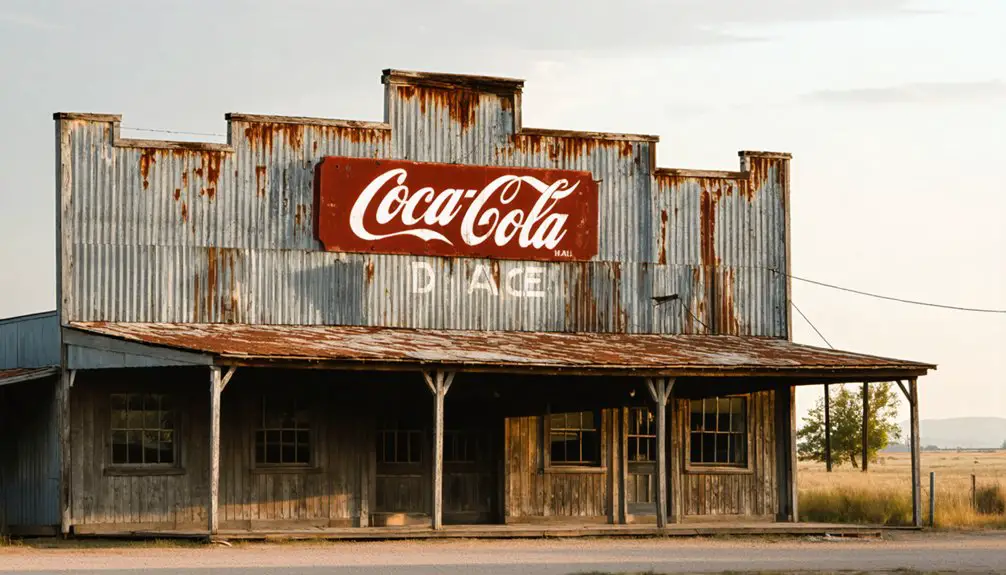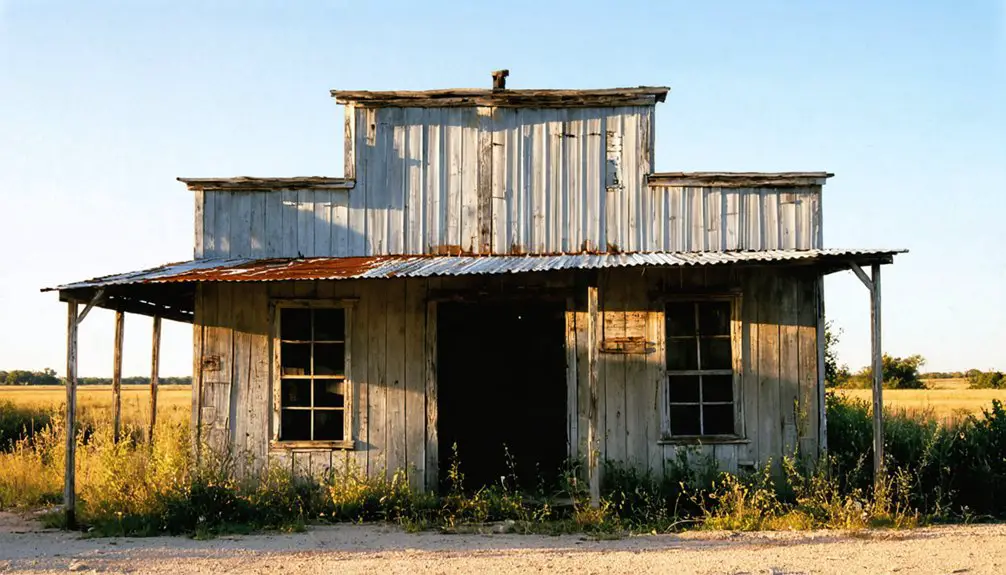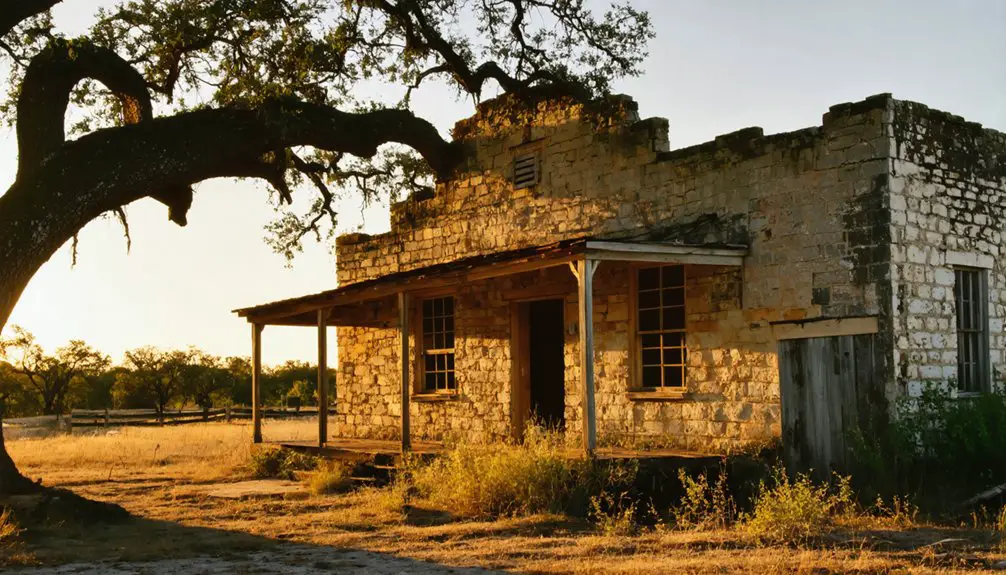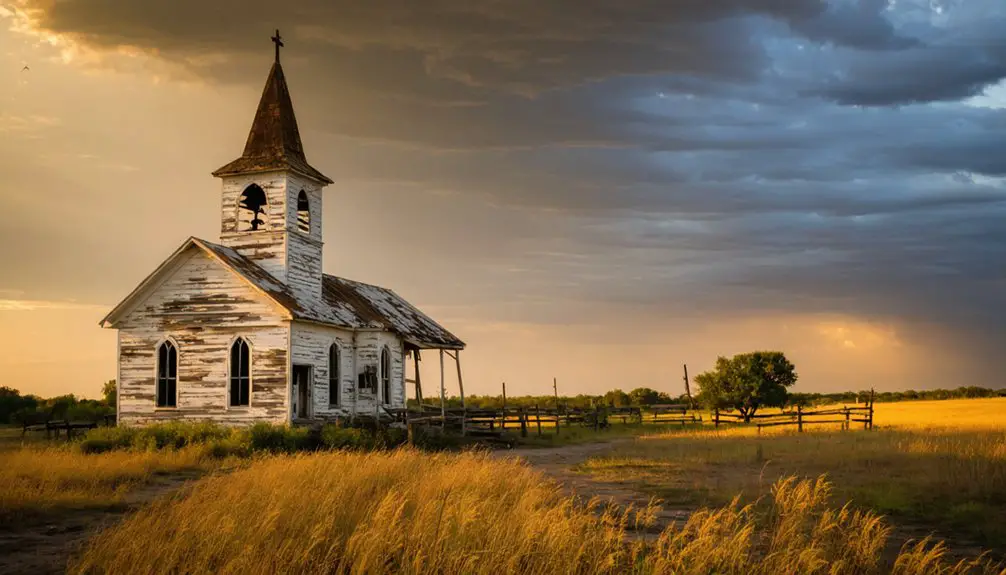You’ll find Albert, Texas about sixteen miles southeast of Fredericksburg, where it began as a stage stop in 1877. Once home to 50 residents in its 1920s peak, this German-Texan settlement now counts just seven inhabitants but maintains its historic charm. The town’s restored dancehall, icehouse, and schoolhouse serve as popular event venues under new ownership since 2004. Behind these preserved buildings lies a fascinating tale of frontier life, presidential connections, and cultural resilience.
Key Takeaways
- Founded in 1877, Albert was a thriving Hill Country community that peaked with 50 residents in the 1920s.
- The town experienced severe population decline, dropping to just 4 residents by 1964 and 7 residents by 2015.
- Historic landmarks include a 1920s dancehall, 1900 schoolhouse, and former general store that closed in 1985.
- Bobby Cave purchased and revitalized Albert in 2004, transforming the ghost town into an active event venue.
- Today, Albert features a restored dancehall, Icehouse, and beer garden hosting weddings, concerts, and community gatherings.
From Settlement to Stage Stop: The Birth of Albert
While seeking fresh grazing lands for their cattle in 1877, Fritz Wilke, George Maenius, and John Petri left Fredericksburg to establish what would become Albert, Texas. They joined early settlers George Cauley, Ben White, Sr., and a man named Jacobs in this untamed stretch of Williams Creek, about sixteen miles southeast of Fredericksburg near the Blanco County line.
The settlement’s significance grew when it became a strategic stop on the Fredericksburg-Blanco stage route. Drivers would change their horses here, making it an essential link between Hill Country communities. The name “Albert” was adopted in 1892 after Albert Luckenbach, who had relocated his business from the nearby town of Luckenbach. The town’s historic dancehall built by Max Beckman in the 1920s still stands as a testament to its rich cultural heritage.
Wilke, a blacksmith, purchased his land from Elmeier, who later met a tragic end during a robbery. The town, originally called Martinsburg, quickly developed around the stage route, sparking the establishment of its first post office in 1877.
Life in Early Albert: Ranching and Community Building
If you’d visited Albert in its early days around 1877, you’d have found pioneering ranchers like Fritz Wilke, George Maenius, and John Petri establishing themselves on the region’s promising grazing lands.
Cattle ranching quickly became the economic backbone of Albert, with the hard work of managing herds and maintaining land shaping the daily lives of its settlers.
The community’s social life centered around gatherings at the local Lutheran mission, school events, and performances by the Albert Echo singing society, which was founded in 1898 to bring cultural enrichment to this rural Texas settlement.
Located in the picturesque Texas Hill Country, Albert offered settlers a strategic position for both ranching and transportation needs.
For historical accuracy and clarity, researchers often consult disambiguation pages to distinguish this Albert from other similarly named locations across Texas and beyond.
Ranching Origins and Settlement
When Fritz Wilke, George Maenius, and John Petri left Fredericksburg in 1877 seeking fresh cattle grazing lands, they established what would become Albert, Texas. These pioneers weren’t the first to discover the area’s potential – early settlers like George Cauley, Ben White, Sr., and a man named Jacobs had already recognized the land’s value.
The settlement’s ranching techniques evolved to match the rugged Hill Country terrain, with ranchers strategically using Williams Creek for their cattle operations. The community maintained a post office until 1886, serving as a vital communication link for the growing settlement.
Wilke, a skilled blacksmith, bought his land from Elmeier, whose murder during a robbery marked one of the settlement’s early challenges. Originally named Martinsburg, the community’s location near the Blanco County line proved ideal for cattle operations, though settlement challenges included adapting to the sparse rural environment and establishing essential services for the growing ranching community. The town later changed its identity when it was renamed after Albert Luckenbach in 1892.
Community Gatherings and Activities
The heart of Albert’s social life centered around three essential community hubs: the Williams Creek School, the Albert Dancehall, and the general store.
Since 1891, you’d find locals gathering at the school for Community Club meetings, while the 1920s-built dancehall became the weekend hotspot for social traditions and entertainment.
You couldn’t miss the vibrant community connections forged through the Albert Echo Singing Society and German brass bands that regularly performed at the dancehall.
The venue’s wood beams, tin covering, and clever ventilation flaps made it perfect for summer festivities.
Today in Martinsburg County, where Albert was established in 1877, only scattered ruins and a cemetery remain as silent witnesses to this once-thriving community.
While the general store closed in the 1980s, the school and dancehall maintained their roles as social anchors, hosting multi-generational events that kept Albert’s rural spirit alive through music, dance, and seasonal celebrations.
Even today, the dancehall remains a popular destination where visitors can enjoy beer under oak trees while taking in the historic atmosphere.
The Lutheran Legacy and Presidential Connection
You’ll find traces of LBJ’s early school years intertwined with Albert’s Lutheran heritage, as he attended classes in the same one-room schoolhouse where Trinity Lutheran Church first organized in 1902.
The Lutheran mission’s spiritual influence reached well beyond Albert’s borders, establishing congregations throughout Gillespie County that served German-speaking settlers until 1950. The church’s Gothic Revival design features notable arched windows that have become a distinctive landmark in the area. The current structure, erected in 1928, still stands as a testament to the congregation’s enduring presence.
Years later, when LBJ became president, he maintained his connection to Albert’s Lutheran community by supporting local initiatives like Head Start programs at Trinity Lutheran Church.
LBJ’s School Years
Located near LBJ’s birthplace, Albert’s historic schoolhouse played a significant role in both Lutheran heritage and presidential legacy.
You’ll find this schoolhouse stood beside Trinity Lutheran Church, established in 1902, where German services continued until 1950, reflecting the area’s cultural roots.
While LBJ’s own family practiced Disciples of Christ, he’d later forge deep connections to Albert’s Lutheran community. He and Lady Bird regularly attended Trinity Lutheran services during their visits to the LBJ Ranch.
This early exposure to education’s power in Albert’s rural setting would shape LBJ’s legacy of educational reform. You can trace his commitment to universal education access from these humble beginnings through his landmark Elementary and Secondary Education Act of 1965, which transformed America’s educational landscape.
Mission’s Regional Religious Impact
Since establishing its presence in 1902, Albert’s Lutheran mission grew from humble meetings in the schoolhouse to become an essential religious hub serving multiple Hill Country communities.
You’ll find that this Lutheran community shaped the region’s spiritual heritage through its network of congregations, including St. Paul Lutheran Church at Cave Creek, which branched off from Fredericksburg’s Zion Lutheran Church in 1883.
The mission’s impact extended far beyond Sunday services. It preserved German-Texan traditions and even played a role in young Lyndon Johnson’s upbringing, as he attended services at the Lutheran Church of Stonewall.
The church’s dedication to serving remote areas helped maintain faith and cultural identity across Gillespie County, despite the challenges of distance and infrequent clergy visits.
A Town’s Peak Years: 1920s Albert
During the roaring 1920s, Albert, Texas reached its zenith as a vibrant Hill Country community of 50 residents, anchored by its iconic dancehall, general store, and Williams Creek School.
In the heart of Texas Hill Country, Albert flourished as a tight-knit community where music, commerce, and education shaped daily life.
The town’s dance traditions and community resilience were on full display during this golden era, with the Albert Echo Singing Society leading the charge in preserving German-Texan heritage.
You’d have experienced:
- Weekend gatherings at Max Beckman’s tin-roofed dancehall, where German brass bands played while side flaps kept dancers cool.
- Daily life centered around Otto Schumann’s general store, a community hub since 1897.
- Children attending the Williams Creek School, including young Lyndon B. Johnson.
- Regular performances by the Albert Echo, founded in 1898, showcasing the town’s rich musical culture.
Cultural Hub: The Albert Echo and Dance Hall Era

You’d find Albert’s cultural heart beating strongest at its iconic 1922 dance hall, where Max Beckman’s tin-covered structure hosted rotating German brass bands and boot-scooting festivities every Saturday night.
The hall’s clever design, with side flaps for ventilation, kept dancers comfortable as they twirled beneath wooden beams, while nearby communities from Luckenbach, Hye, and Weinheimer shared musical talent that echoed through the Texas Hill Country.
Your Saturday nights in Albert meant joining neighbors under those rafters, where the German-Texan heritage came alive through music and dance, creating bonds that held the community together despite the town’s small size.
Music Brings Community Together
While many small Texas towns faded into obscurity, Albert’s vibrant musical heritage kept its community spirit alive through the Albert Echo Singing Society and its iconic dance hall.
The singing society, established in 1898, played a vital role in preserving German-Texan cultural identity through shared musical traditions.
You’ll find this rich heritage reflected in:
- Saturday night dances at Max Beckman’s 1922 dance hall, where German brass bands rotated between regional venues
- The Albert Echo’s performances of folk songs that strengthened intergenerational bonds
- Community gatherings at the Ice House, where live music merged with games of dominoes and horseshoes
- A regional music network spanning Fredericksburg, Johnson City, and neighboring Hill Country communities
The fusion of traditional German-Texan music with contemporary country styles continues to bridge past and present, keeping Albert’s cultural spirit strong.
Town’s Entertainment Epicenter
Throughout the 1920s, Max Beckman’s newly constructed dance hall emerged as Albert’s beating heart of entertainment and cultural life. You’d find the wood-beamed, tin-covered venue alive with dancehall activities every weekend, its clever side flaps opened wide to catch summer breezes.
The Albert Echo Singing Society, founded in 1898, made the hall their performance home, filling it with German brass bands and traditional songs that kept their heritage vibrant. Community events flourished here for nearly a century, from the Gillespie County Singing Festival to local gatherings at the nearby Williams Creek School.
Even as Albert faced decline, Bobby Cave’s 2004 Icehouse revival breathed new life into the town’s entertainment scene, ensuring these cherished cultural traditions would continue for future generations.
The Slow Fade: Tracking Albert’s Population Decline
Despite beginning as a modestly populated settlement, Albert, Texas experienced a stark population decline that transformed it from a small but essential community into a near ghost town.
Once thriving with community life, Albert, Texas now stands as a haunting reminder of small-town decline in rural America.
The population trends tell a story of dwindling community resilience over nearly a century:
- You’d have found 50 residents calling Albert home in 1925, representing the town’s peak population.
- By 1964, you’d have seen just 4 residents remaining, marking the most dramatic decline.
- A brief revival brought 25 residents back by 1972, holding steady through 2000.
- Today, you’ll find only 7 residents, as of 2015, highlighting the town’s continued fade.
This steady exodus paralleled the closure of crucial community institutions, from the post office to the general store, each departure marking another step toward ghost town status.
Architecture and Infrastructure Through Time

As settlers like Fritz Wilke and George Maenius arrived in 1877, Albert’s architectural story began with humble frontier structures that would shape this Texas Hill Country community for generations.
The settlement patterns reflected both necessity and German cultural influences, with native limestone and wooden beam construction defining the town’s character.
You’ll find the 1920s Dancehall standing as the town’s architectural crown jewel, complete with side flaps for ventilation and a signature tin roof.
The 1900 schoolhouse, which once hosted young Lyndon Johnson, remains behind the Dancehall as a symbol of rural education.
While the original 1897 general store didn’t survive past 1985, its site found new life in 2004 as the Albert Icehouse.
Today, these remaining structures showcase the practical, climate-adapted building techniques of early Texas frontier life.
Modern Albert: From Abandonment to Ebay
When Albert’s population plummeted in the 1930s, the once-thriving Hill Country town entered a prolonged period of decline that would last until the early 2000s.
The closing of the general store in the 1980s marked the end of an era, leaving just a handful of residents to call Albert home.
You’ll find the town’s modern revival began in 2004 when insurance broker Bobby Cave purchased Albert and initiated its transformation.
The community’s rebirth includes:
- Restoration of the iconic Icehouse, replacing the old general store
- Preservation of the historic dancehall as an active music venue
- Reopening of the schoolhouse for community gatherings
- A groundbreaking eBay auction in 2007 that attracted global attention
Today, under new ownership, Albert continues welcoming visitors while maintaining its authentic Hill Country charm through events and hospitality ventures.
Preserving a Piece of Texas Hill Country History

The preservation of Albert’s rich Texas Hill Country heritage stands as a tribute to both historical significance and community determination.
You’ll find this resilience reflected in the carefully maintained Williams Creek Schoolhouse where LBJ once studied, and the iconic Albert Dancehall with its strategic ventilation flaps and tin roofing.
While the town’s population has dwindled to just seven residents by 2015, private owners have stepped up to protect these architectural treasures.
The limestone buildings and original layout still tell the story of 19th-century rural Texas life, while adapted spaces like the schoolhouse-turned-community center keep history alive through modern use.
Adapted yet authentic, Albert’s historic structures bridge past and present, preserving rural Texas heritage while serving today’s community needs.
The town’s German-Texan cultural influence lives on through its preserved venues and enduring musical legacy.
Reimagining Albert: New Life as an Event Venue
Modern-day Albert shines as one of Texas Hill Country‘s premier event destinations, anchored by its majestic 80-by-55-foot historic dancehall.
This thoughtful blend of historical preservation and event planning creates an authentic setting that’ll transport you back to Texas’ storied past.
When you’re hosting your special occasion at Albert, you’ll discover:
- A versatile dancehall that accommodates 250+ guests, complete with bar tables, stools, and a stage for live entertainment
- A sprawling 12-acre Icehouse and Beer Garden shaded by 500-year-old oaks
- ADA-compliant facilities with ample parking and an EV charging station
- Flexible year-round scheduling for weddings, reunions, corporate gatherings, and traditional Texas dances
Since Bobby Cave’s 2004 restoration, Albert’s transformed from a ghost town into a cherished venue where Hill Country heritage meets modern celebration needs.
Frequently Asked Questions
Are There Any Reported Ghost Stories or Paranormal Activities in Albert?
You won’t find documented ghost sightings or paranormal investigations in Albert – the ghost town’s name refers to its abandoned status rather than any supernatural activity in its quiet history.
What Natural Disasters or Severe Weather Events Has Albert Experienced?
In July 2021, floodwaters rose 26 feet in 45 minutes near you. While Albert’s specific flood events aren’t uniquely documented, you’ll find the town’s faced Central Texas’s characteristic flash floods and severe storms.
What Were the Primary Crops Grown by Early Settlers?
You’ll find that settlers relied heavily on corn cultivation for food and feed, alongside wheat, oats, and sorghum. They didn’t focus on cotton farming, preferring crops suited to the Hill Country’s conditions.
Did Any Famous Outlaws or Criminals Ever Pass Through Albert?
Despite Albert’s population of 50 in 1925, you won’t find records of famous outlaws or criminal activities there. It was a peaceful stage stop, focused on ranching rather than attracting troublemakers.
What Native American Tribes Originally Inhabited the Albert Area?
You’ll find that Coahuiltecan bands originally occupied the area’s tribal history, while Comanche and Apache later moved through the region. The land held deep cultural significance for these indigenous peoples.
References
- https://en.wikipedia.org/wiki/Albert
- https://www.tshaonline.org/handbook/entries/albert-tx
- https://www.hillcountryportal.com/albert.html
- https://txprobatelawyer.net/the-rise-of-ghost-towns-can-you-own-a-piece-of-abandoned-texas/
- https://www.texasescapes.com/MichaelBarr/Drinking-Beer-Under-the-Trees-at-Albert.htm
- https://texashillcountry.com/hill-country-ghost-town-road-trip/
- https://www.texasescapes.com/TexasHillCountryTowns/Albert-Texas.htm
- https://www.onlyinyourstate.com/trip-ideas/texas/blink-and-youll-miss-it-town-tx
- https://alberttexas.com/pages/history
- https://kids.kiddle.co/Albert



